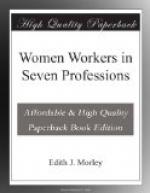It is not, perhaps, widely known that women have already made their way into many branches of the Service and have done invaluable work therein. Perhaps the strongest argument that can be urged in favour of their admission into yet other branches of the Service will be found in the following brief survey of the appointments held and the work already done by them in various directions.
The Local Government Boards
The credit of being the first Government Department to appoint a Woman Inspector belongs to the English Local Government Board. As far back as 1873, yielding to the pressure of public opinion, that Board appointed a Woman Inspector, with full powers to inspect workhouses, and district schools. During the short period of her appointment, this lady did excellent work, and called attention to much needed reforms in the education of girls in Poor Law Schools. Unfortunately, owing to a breakdown in health, she was obliged to resign her appointment in November 1874, and the Local Government Board, either repenting of its enlightened action, or not appreciating the aid of a woman even in matters concerning the welfare of women and girls, refrained from appointing a woman to succeed her. It was not until 1885 that another Woman Inspector was appointed, and then her work was restricted to the inspection of Poor Law Children boarded out beyond the Union to which they belonged. In 1896, once more by reason of the pressure of public opinion, a woman was appointed as an Assistant Inspector of Poor Law Institutions in the Metropolis. In 1898 a second Inspector of Boarded-out Children was appointed, and in 1903 the number of Inspectors was increased to three, each Inspector having a district assigned to her.
Four years ago the total number of Women Inspectors was increased to seven, and the scope of their duties somewhat widened, as will be seen below. There is now one Superintendent Inspector at a salary of L400 to L450, and six Inspectors at L250 to L350. Candidates for these inspectorships must have had considerable administrative experience. They must hold a certificate of three years’ training as a Nurse, and the Central Midwives’ Board’s certificate is considered desirable. These qualifications have only been required since 1910.
The duties assigned to the Women Inspectors include (1) the inspection of boarded-out children, both within and beyond the Poor Law Unions to which they belong; and (2) the inspection of Poor Law Institutions—i.e., infirmaries, sick wards of workhouses, maternity wards, and workhouse nurseries: also of Certified Homes, Cottage Homes, and Scattered Homes.
The duties of the Women Inspectors in connection with the boarding-out of Poor Law Children include the visiting of officials of Boarding-Out Committees, and of homes in which children are boarded out; the Inspector visits a sufficient number of children and homes to enable her to satisfy herself that the duties of the Boarding-Out Committee are carried out in a satisfactory manner, and makes a report to the Board thereon. Women Inspectors arrange their own inspections of boarded-out children within a prescribed district.




